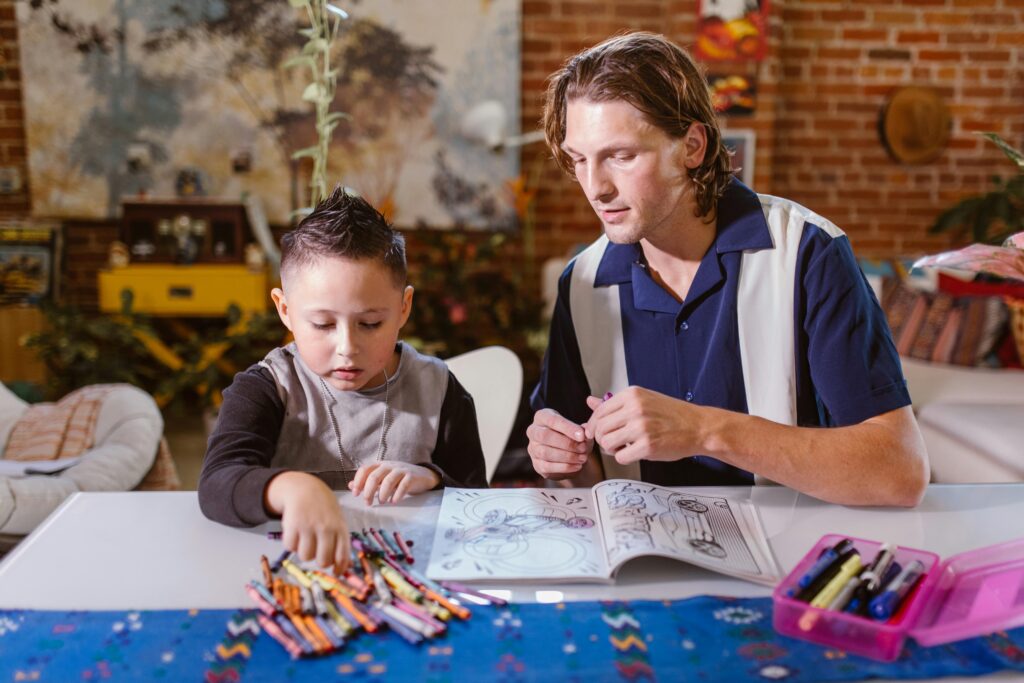Introduction
Juggling school drop‑offs, playdates, work deadlines, and household chores often leaves parents feeling like they’re running on empty. Mindful parenting offers a path to stay present with your children—deepening connections, reducing tantrums, and fostering calm at home. Yet, intentionally slowing down can sometimes spotlight every slip‑up, amplifying feelings of guilt or “not doing enough.” In this post, we’ll dive into both the uplifting and challenging sides of mindful parenting, share real‑life examples from busy families, and provide practical tips, a Q&A, and an FAQ section to help you bring genuine calm to your parenting journey.
1. What Is Mindful Parenting?

Mindful parenting means being fully present with your child—tuning into their needs, your reactions, and the moment itself without judgment. Instead of operating on autopilot, you:
- Notice emotional triggers. Recognize when you’re getting frustrated or impatient.
- Pause before reacting. Take a breath instead of snapping in the heat of the moment.
- Listen deeply. Truly hear what your child is saying—even when it’s through tears or tantrums.
Positive Side: You build stronger trust and empathy, creating a safe emotional space.
Negative Side: You may become hyper‑aware of your own mistakes, leading to heightened parental guilt.
2. The Benefits: More Connection and Less Chaos
2.1 Improved Communication
When you practice mindful listening—making eye contact, setting aside your phone—children feel heard and valued.
- Example: Shruti, mom of two toddlers, found that pausing to kneel at eye‑level and repeat her child’s words (“You’re upset because you dropped your toy”) cut morning meltdowns by half.
2.2 Reduced Parental Stress
By noticing rising tension (“I feel my shoulders tighten”), you can take a quick breath or step away—avoiding a full‑blown argument.
- Example: Rohan, a single dad, uses the three‑minute breathing space after school pickups. He reports fewer evenings spent yelling and more spent in calm play.
2.3 Better Emotional Regulation in Kids
Children model what they see. When you show calmness in stressful moments, kids learn to self‑soothe.
- Example: Meena started a bedtime “gratitude circle,” where each family member names one happy moment from the day. Over weeks, her son’s bedtime anxiety eased noticeably.
3. The Challenges: When Mindfulness Feels Like Another To‑Do

3.1 The Guilt Trap
- Noticing every impatient thought (“I snapped again”) can spiral into self‑criticism: “I’m a bad parent.”
3.2 Time Constraints
- Carving out dedicated mindfulness practice may feel impossible amid soccer practice, homework help, and meal prep.
3.3 Unrealistic Expectations
- Believing mindful parenting means never losing your temper sets an unattainable standard, leading to disappointment.
Real‑Life Hiccup: Kavita attempted a daily 20‑minute morning meditation—but missing sessions on workdays made her feel like a failure, so she quit altogether.
Key Insight: Mindful parenting is a spectrum—not a perfect state. Small, imperfect moments of presence still matter.
4. Practical Mindful Parenting Techniques
4.1 The “Pause and Breathe” Trick
When a child tests your patience, silently count to three as you inhale and exhale. This simple break often defuses tension before words fly.
4.2 Mindful Mealtimes
- Step 1: Before the first bite, invite everyone to take a deep breath together.
- Step 2: Encourage children to discuss one thing they notice about the food—color, texture, taste.
4.3 Emotion Labeling
Teach kids—and yourself—to name big feelings: “I see you’re angry because you can’t have that toy right now.” Labels help diffuse intensity.
4.4 Guided Family Check‑Ins
Use a feelings chart after school or on car rides. Each person picks an emoji that matches their mood and briefly shares why.
4.5 Quick Body Scan
While rocking a baby or waiting in the carpool line, mentally scan from head to toe—notice any tension and soften it with a breath.
5. Integrating Mindfulness into Everyday Routines
- Pair with Daily Habits: After brushing teeth, pause and feel the bristles’ sensation for five seconds.
- Use Visual Cues: Place a small sticky note on the fridge that reads “Pause.” Every time you open it, take a mindful breath.
- Family Mindful Minutes: Set a shared timer for one minute of silence before homework or bed.
- Mindful Transitions: Between activities (school to play, play to dinner), take one mindful breath together.
6. Real‑Life Stories of Transformation
- Story of the Khanna Family: With three kids under 8, dinner time was chaotic. After introducing a “gratitude jar” ritual—writing one thing each person loved about the day—the table atmosphere shifted from nagging to sharing.
- Story of Arjun and Meera (Co‑Parents): Divorced but co‑parenting, they struggled with tense handovers. They agreed to a three‑deep‑breaths ritual before exchanging kids, which improved their communication and reduced children’s anxiety.
Q&A Section
- Q: How much time should I spend on mindful parenting each day?
A: You don’t need blocked “me time.” Even 5–10 seconds—a quick breath before responding—counts as mindful parenting. - Q: What if my child refuses to join in?
A: Model the practice yourself. Over time, curiosity may spark their participation. - Q: Can mindful parenting fix tantrums?
A: It won’t eliminate them, but it helps you respond calmer—reducing their frequency and intensity. - Q: Is it okay to meditate when my kids nap?
A: Absolutely! Use that quiet window—even a three‑minute guided practice refuels your patience. - Q: How do I avoid feeling guilty about imperfect practice?
A: Remember that mindfulness is about noticing, not perfection. Spotting impatience is a win, because awareness is the first step to change.
FAQ Section
- What age is best to start mindful parenting?
Any age—even toddlers benefit from simple breathing games or sensory check‑ins. - Do I need special training or apps?
No—basic awareness and breath focus work wonders. Apps can help beginners but aren’t required. - Will mindfulness take time away from fun activities?
Mindful moments often make fun activities richer—paying full attention to a game or story enhances enjoyment. - Can single parents practice mindful parenting?
Definitely. Short pauses and self‑compassion are vital, especially when you’re wearing many hats. - How quickly will I see changes?
Some shifts—like calmer responses—may appear within days. Deeper changes in family dynamics often evolve over weeks or months.
Friendly Closing Message
Mindful parenting isn’t about achieving perfection; it’s about weaving small moments of presence into your busy days. Even a three‑second pause before reacting can change the atmosphere in your home, deepen bonds, and model emotional resilience for your children. Start small—pick one technique above, try it today, and notice how it feels. Your journey toward calmer, more connected parenting begins with a single mindful breath. You’ve got this! 🌟👨👩👧👦
You can also read article of W.H.O on guidelines of parenting.

Pingback: Mindfulness for Healthcare Professionals: A Lifeline in Chaos (Yet Often Overwhelming to Implement) - Calm Within Minutes
Pingback: Mindful Boundaries for Caregivers: Protect Your Energy Without Losing Heart - Calm Within Minutes
Pingback: Mindful Sleep Strategies for Caregivers: Rest Better So You Can Care Better - Calm Within Minutes
Pingback: Quick Mindfulness Practices for Busy Caregivers: 1–5 Minute Resets That Actually Work - Calm Within Minutes